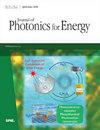太阳能泵浦激光功率与激光介质长度相关性的研究
IF 2.1
4区 工程技术
Q4 MATERIALS SCIENCE, MULTIDISCIPLINARY
引用次数: 0
摘要
摘要当激光介质长度不合适时,太阳能泵浦激光器的效率受到限制。这是因为激光介质中的多余区域引入了损耗,并且对激光谐振腔中的辐射刺激有轻微的贡献。在设计声压级光源之前,选择合适的激光介质长度是至关重要的。通过研究不同激光介质长度下太阳能吸收功率与材料损耗之间的关系,提出了一种计算增益介质最佳长度的方法。为此,对直径为3 ~ 6 mm的Nd:YAG晶体长度进行了优化,并对其输出特性进行了数值计算。对于直径5.5 mm、长度21.1 mm的Nd:YAG晶体棒,获得了最大的收集效率(CE) (40.1 W / m2),比之前的数值记录提高了1.7 W / m2。发现直径为6 mm的Nd:YAG晶体棒的最佳长度为21.9 mm。对于这种长度的激光棒,期望CE为36.3 W / m2。这一数值是现有相同直径Nd:YAG晶体实验记录的1.13倍,突出了优化激光棒长度的重要性。本文章由计算机程序翻译,如有差异,请以英文原文为准。
Investigation of dependence of solar-pumped laser power on laser medium length
Abstract. The efficiency of solar-pumped lasers (SPLs) is limited when the length of the laser medium is unsuitable. This is because superfluous regions in the laser medium introduce losses and contribute slightly to the stimulation of radiation in the laser resonator. Before designing an SPL, an appropriate length of laser medium is critical. We present a method to calculate the optimal length of the gain medium in SPLs by exploring the relationship between the absorbed solar power and material loss for different laser medium lengths. Thus, the lengths of Nd:YAG crystals with diameters of 3 to 6 mm were optimized, and the output characteristics were calculated numerically. The maximum collection efficiency (CE) (40.1 W / m2) was obtained for the 5.5-mm diameter Nd:YAG crystal rod of length 21.1 mm, which was 1.7 W / m2 higher than the previous numerical record. The optimal length of the 6-mm diameter Nd:YAG crystal rod was found to be 21.9 mm. For a laser rod of this length, a CE of 36.3 W / m2 is expected. This value is 1.13 times greater than the existing experimental record for the Nd:YAG crystal of the same diameter, which highlights the importance of optimizing the length of the laser rod.
求助全文
通过发布文献求助,成功后即可免费获取论文全文。
去求助
来源期刊

Journal of Photonics for Energy
MATERIALS SCIENCE, MULTIDISCIPLINARY-OPTICS
CiteScore
3.20
自引率
5.90%
发文量
28
审稿时长
>12 weeks
期刊介绍:
The Journal of Photonics for Energy publishes peer-reviewed papers covering fundamental and applied research areas focused on the applications of photonics for renewable energy harvesting, conversion, storage, distribution, monitoring, consumption, and efficient usage.
 求助内容:
求助内容: 应助结果提醒方式:
应助结果提醒方式:


